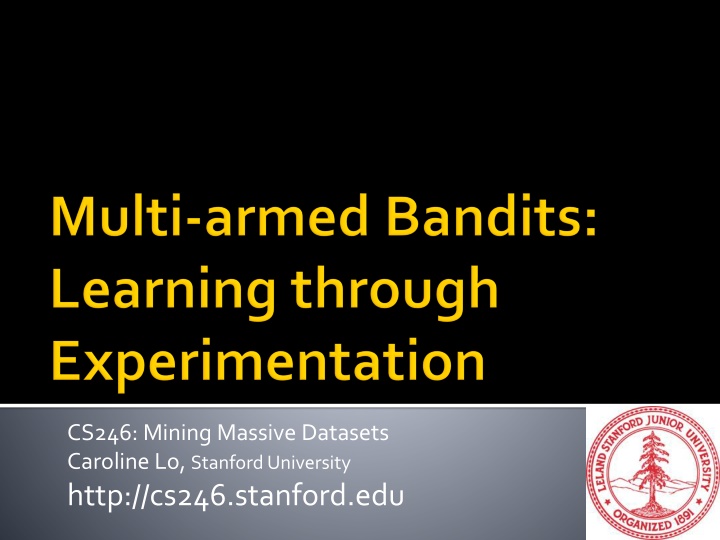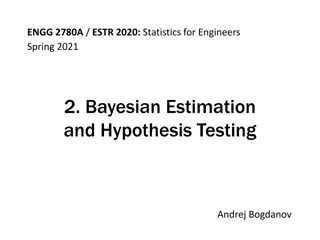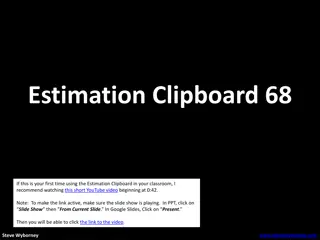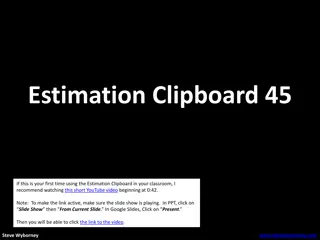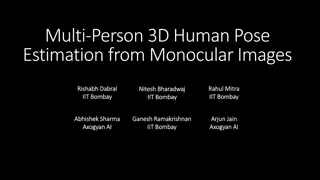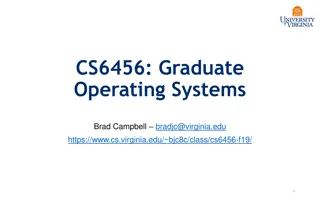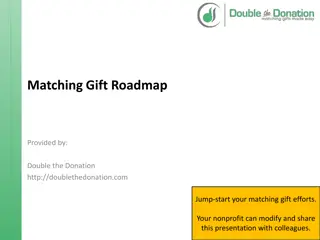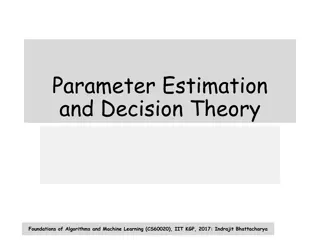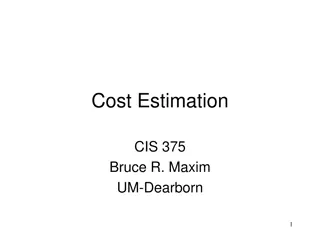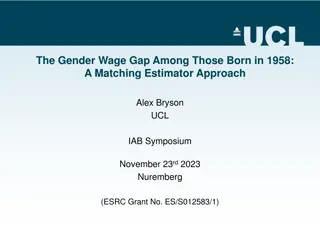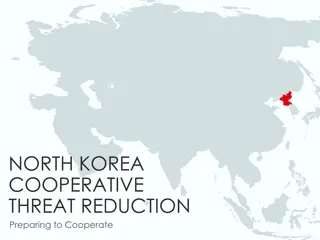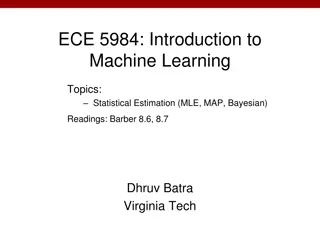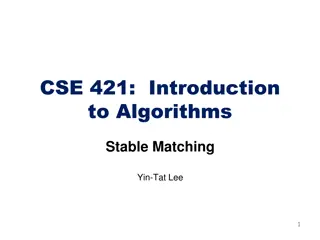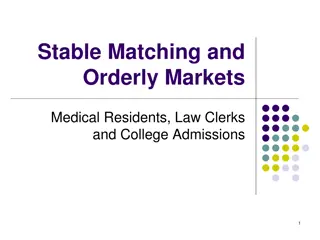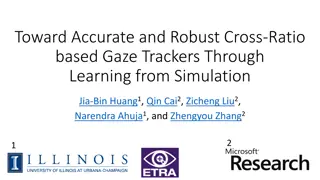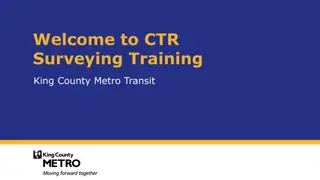Learning Real-time Advertiser Matching and CTR Estimation
In the realm of web advertising and recommendation systems, understanding concepts like Click-Through Rate (CTR) estimation and solving the cold-start problem is crucial. Through experimentation and data gathering, insights into maximizing revenue and optimizing ad effectiveness are gained. Explore themes of learning through experimentation, revenue maximization strategies, and the importance of expected revenue in ad bidding. Dive into topics like adaptive routing, asset pricing, and clinical trials, all while aiming to make the most money and minimize losses.
Download Presentation

Please find below an Image/Link to download the presentation.
The content on the website is provided AS IS for your information and personal use only. It may not be sold, licensed, or shared on other websites without obtaining consent from the author.If you encounter any issues during the download, it is possible that the publisher has removed the file from their server.
You are allowed to download the files provided on this website for personal or commercial use, subject to the condition that they are used lawfully. All files are the property of their respective owners.
The content on the website is provided AS IS for your information and personal use only. It may not be sold, licensed, or shared on other websites without obtaining consent from the author.
E N D
Presentation Transcript
CS246: Mining Massive Datasets Caroline Lo, Stanford University http://cs246.stanford.edu
Web advertising We ve learned how to match advertisers to queries in real-time But how to estimate the CTR (Click-Through Rate)? Recommendation engines We ve learned how to build recommender systems But how to solve the cold-start problem? 2/18/2025 2
What do CTR and cold start have in common? Getting the answer requires experimentation With every ad we show/ product we recommend we gather more data about the ad/product Theme: Learning through experimentation 2/18/2025 3
Googles goal: Maximize revenue The old way: Pay by impression (CPM) 2/18/2025 4
Googles goal: Maximize revenue The old way: Pay by impression (CPM) Best strategy: Go with the highest bidder But this ignores effectiveness of an ad The new way:Pay per click! (CPC) Best strategy: Go with expected revenue What s the expected revenue of ada for query q? E[revenuea,q] = P(clicka | q) * amounta,q Bid amount for ad a on query q (Known) Prob. user will click on ad a given that she issues query q (Unknown! Need to gather information) 2/18/2025 5
Clinical trials: Investigate effects of different treatments while minimizing patient losses Adaptive routing: Minimize delay in the network by investigating different routes Asset pricing: Figure out product prices while trying to make most money 2/18/2025 6
Each arm a Wins (reward=1) with fixed (unknown) prob. a Loses (reward=0) with fixed (unknown) prob. 1- a All draws are independent given 1 k How to pull arms to maximize total reward? 2/18/2025 9
How does this map to our advertising example? Each query is a bandit Each ad is an arm We want to estimate the arm s probability of winning a(i.e., the ad s CTR a) Every time we pull an arm we do an experiment 2/18/2025 10
The setting: Set of kchoices (arms) Each choice a is tied to a probability distribution Pa with average reward/payoff a (between [0, 1]) We play the game for T rounds For each round t: (1) We pick some arm j (2) We win reward ?? drawn from Pj Note reward is independent of previous draws Our goal is to maximize ?=? We don t know a! But every time we pull some arm a we get to learn a bit about a ? ?? 2/18/2025 11
Online optimization with limited feedback Choices X1 X2 a1 a2 0 X3 X4 X5 1 X6 1 1 0 ak 0 Time Like in online algorithms: Have to make a choice each time But we only receive information about the chosen action 2/18/2025 12
Policy: a strategy/rule that in each iteration tells me which arm to pull Hopefully policy depends on the history of rewards How to quantify performance of the algorithm? Regret! 2/18/2025 13
??is the mean of ?? Payoff/reward of best arm: ? = ??? ?? ? Let ??,?? ?? be the sequence of arms pulled Instantaneous regret at time ?: ??= ? ??? Total regret: ? ??= ?? ?=? Typical goal: Want a policy (arm allocation strategy) that guarantees: ?? ? ? as ? Note: Ensuring ??/? 0 is stronger than maximizing payoffs (minimizing regret), as it means that in the limit we discover the true best arm. 2/18/2025 14
If we knew the payoffs, which arm would we pull? ???? ?????? ?? ? We d always pull the arm with the highest average reward. But we don t know which arm that is without exploring/experimenting with the arms first. ??,? payoff received when pulling arm ? for ?-th time 2/18/2025 15
Minimizing regret illustrates a classic problem in decision making: We need to trade off exploration (gathering data about arm payoffs) and exploitation (making decisions based on data already gathered) Exploration: Pull an arm we never pulled before Exploitation: Pull an arm ? for which we currently have the highest estimate of ?? 2/18/2025 16
Algorithm: Epsilon-Greedy For t=1:T Set ??= ?(?/?) With prob. ??:Explore by picking an arm chosen uniformly at random With prob.? ??: Exploit by picking an arm with highest empirical mean payoff Theorem [Auer et al. 02] For suitable choice of ?? it holds that ??= ?(?log?) ?? ?= ? ? log ? ? 0 k number of arms 2/18/2025 17
What are some issues with Epsilon Greedy? Not elegant : Algorithm explicitly distinguishes between exploration and exploitation More importantly: Exploration makes suboptimal choices (since it picks any arm with equal likelihood) Idea: When exploring/exploiting we need to compare arms 2/18/2025 18
Suppose we have done experiments: Arm 1: 1 0 0 1 1 0 0 1 0 1 Arm 2: 1 Arm 3: 1 1 0 1 1 1 0 1 1 1 Mean arm values: Arm 1: 5/10, Arm 2: 1, Arm 3: 8/10 Which arm would you pick next? Idea: Don t just look at the mean (that is, expected payoff) but also the confidence! 2/18/2025 19
A confidence interval is a range of values within which we are sure the mean lies with a certain probability We could believe ?? is within [0.2,0.5] with probability 0.95 If we have tried an action less often, our estimated reward is less accurate so the confidence interval is larger Interval shrinks as we get more information (i.e. try the action more often) 2/18/2025 20
Assuming we know the confidence intervals Then, instead of trying the action with the highest mean we can try the action with the highest upper bound on its confidence interval This is called an optimistic policy We believe an action is as good as possible given the available evidence 2/18/2025 21
99.99% confidence interval After more exploration ?? ?? arm a arm a 2/18/2025 22
Suppose we fix arm a: Let ??,? ??,? be the payoffs of arm a in the first m trials ??,? ??,? are i.i.d. rnd. vars. with values in [0,1] Expected mean payoff of arm a: ??= ?[??,?] Our estimate: ??,?= Want to find confidence bound ? such that with high probability ?? ??,? ? Also want ? to be as small as possible (why?) ? ? =? ? ??, Goal: Want to bound ?( ?? ??,? ?) 2/18/2025 23
Hoeffdings inequality bounds ?( ?? Let ?? ?? be i.i.d. rnd. vars. with values between [0,1] ??,? ?) ? ? =? ? Let ? = ?[?] and ??= ? ?? ? ??? ???? = ? Then:? ? To find out the confidence interval ? (for a given confidence level ?) we solve: ? 2?2? ?then 2?2? ln(?) ?? ?/? ? ? So:? 2/18/2025 24
[Auer et al. 02] UCB1 (Upper confidence sampling)algorithm Set: ??= = ??= ? and ??= = ??= ? ?? is our estimate of payoff of arm ? ?? is the number of pulls of arm ? so far For t = 1:T Upper confidence interval (Hoeffding s inequality) ? ln ? ?? For each arm a calculate: ??? ? = ??+ Pick arm ? = ??? ???? ??? ? Pull arm ? and observe ?? ? Set: ?? ??+ ? and ??(??+ ?? ? ?? ??) 2/18/2025 25
?? ?/? ? ? ? ln ? ?? ? ??? ? = ??+ ? impacts the value of ?: ? = ? ?/? Confidence interval grows with the total number of actions ? we have taken But shrinks with the number of times ?? we have tried arm ? This ensures each arm is tried infinitely often but still balances exploration and exploitation Optimism in face of uncertainty : The algorithm believes that it can obtain extra rewards by 2/18/2025 reaching the unexplored parts of the state space Jure Leskovec, Stanford CS246: Mining Massive Datasets, http://cs246.stanford.edu 26
Theorem [Auer et al. 2002] Suppose optimal mean payoff is ? = ??? ?? ? And for each arm let??= ? ?? Then it holds that ? + ? +?? ?? ? ?? ? ?? ? ?? ? ?:??<? ?=? ?(? ln?) ?(?) ?? ? ?? ? ? So: ? ? 2/18/2025 27
k-armed bandit problem is a formalization of the exploration-exploitation tradeoff Simple algorithms are able to achieve no regret (limit towards infinity) Epsilon-greedy UCB (Upper Confidence Sampling) 2/18/2025 28
Every round receive context [Li et al., WWW 10] Context: User features, articles view before Model for each article s click-through rate 2/18/2025 29
Feature-based exploration: Select articles to serve users based on contextual information about the user and the articles Simultaneously adapt article selection strategy based on user-click feedback to maximize total number of user clicks 2/18/2025 30
Imagine you have two versions of the website and you d like to test which one is better Version A has engagement rate of 5% Version B has engagement rate of 4% You want to establish with 95% confidence that version A is better You d need 22,330 observations (11,165 in each arm) to establish that Use student s t-test to establish the sample size Can bandits do better? 2/18/2025 31
How long it does it take to discover A > B? A/B test: We need 22,330 observations. Assuming 100 observations/day, we need 223 days Bandits: We use UCB1 and keep track of confidences for each version we stop as soon as A is better than B with 95% confidence. How much do we save? 175 days on the average! 48 days vs. 223 days More at: http://bit.ly/1pywka4 2/18/2025 32
